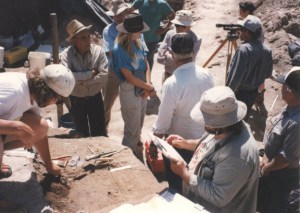
1996 excavation at Hell Gap, a deeply stratified Paleoindian and Archaic site located in the Great Plains of eastern Wyoming, USA. Diagnostic materials include projectile points from the Clovis and Folsom traditions, Agate Basin, Alberta, Frederick, Goshen, and other complexes. Photo taken by Christiane Cunnar.
The Late Paleoindian tradition is found in the unglaciated regions of North America from the Pacific coast to the Atlantic coast and from the Arctic south into the tropical latitudes of Mesoamerica. It occurred from around 11,000 to 6000 BP, generally ending later in the more northern latitudes. This was a time of rapidly changing climate and environment. The people were nomadic hunters and gatherers with an economy emphasizing big game hunting, but including a mix of smaller game and collected plant foods. People lived in small bands, perhaps in recognized territories as seen in the many distinctive projectile point types. Site types include base camps, hunting and butchering stations, and stone tool manufacturing sites. In eHRAF Archaeology click BROWSE TRADITIONS then A-Z index for more info on the Late Paleoindian Tradition.
“Peopling of the Americas” will probably generate some interesting debates at the upcoming Society for American Archaeology (SAA) Meeting in Austin, Texas. If you are attending, make sure to stop by the HRAF booth #212 to check out the online materials we have on Paleo-Indians and other early archaeological traditions North and South America. You can read more on early humans in the Americas in the March, 28 article of the New York Times.
The picture above features the 1996 excavation at Hell Gap, a deeply stratified Paleoindian and Archaic site located in the Great Plains of eastern Wyoming, USA. Diagnostic materials include projectile points from the Clovis and Folsom traditions, Agate Basin, Alberta, Frederick, Goshen, and other complexes.
The middle of the photo depicts Bonnie Pitblado, C. Vance Haynes and George C. Frison. Bonnie Pitblado is now Professor of Anthropology at University of Oklahoma, C. Vance Haynes is now Professor Emeritus of Anthropology at University of Arizona, and George C. Frison is Professor Emeritus of Anthropology at the University of Wyoming. Information on a book published on the Hell Gap Site can be found at University of Utah Press.